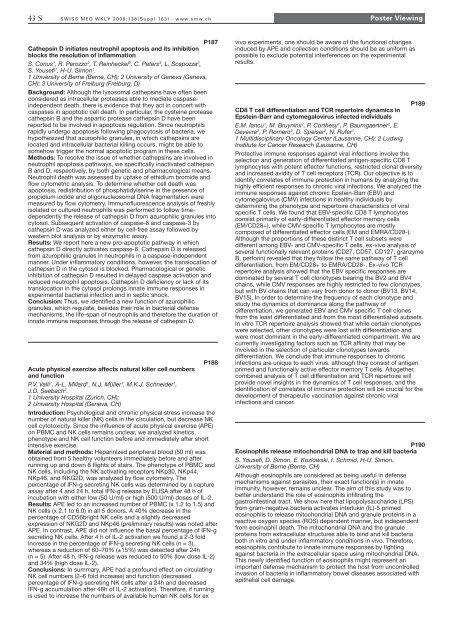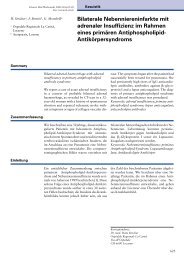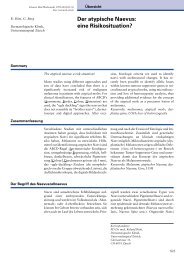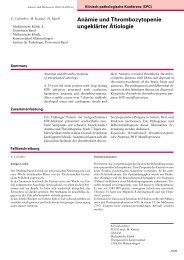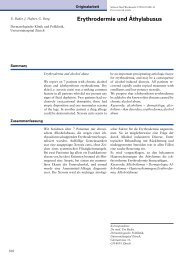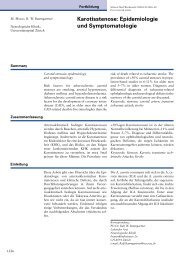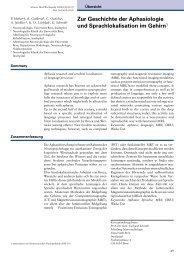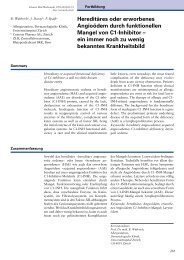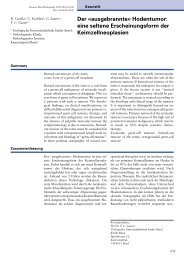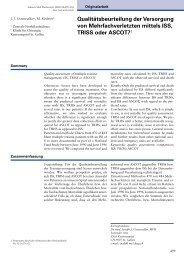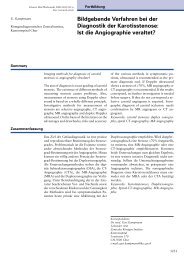Supplementum 163 - Swiss Medical Weekly
Supplementum 163 - Swiss Medical Weekly
Supplementum 163 - Swiss Medical Weekly
You also want an ePaper? Increase the reach of your titles
YUMPU automatically turns print PDFs into web optimized ePapers that Google loves.
43 S SWISS MED WKLY 2008;138(Suppl <strong>163</strong>) · www.smw.ch<br />
Poster Viewing<br />
P187<br />
Cathepsin D initiates neutrophil apoptosis and its inhibition<br />
blocks the resolution of inflammation<br />
S. Conus1 , R. Perozzo2 , T. Reinheckel3 , C. Peters3 , L. Scapozza2 ,<br />
S. Yousefi1 , H-U. Simon1 .<br />
1 University of Berne (Berne, CH); 2 University of Geneva (Geneva,<br />
CH); 3 University of Freiburg (Freiburg, D)<br />
Background: Although the lysosomal cathepsins have often been<br />
considered as intracellular proteases able to mediate caspaseindependent<br />
death, there is evidence that they act in concert with<br />
caspases in apoptotic cell death. In particular, the cysteine protease<br />
cathepsin B and the aspartic protease cathepsin D have been<br />
reported to be involved in apoptosis regulation. Since neutrophils<br />
rapidly undergo apoptosis following phagocytosis of bacteria, we<br />
hypothesized that azurophilic granules, in which cathepsins are<br />
located and intracellular bacterial killing occurs, might be able to<br />
somehow trigger the normal apoptotic program in these cells.<br />
Methods: To resolve the issue of whether cathepsins are involved in<br />
neutrophil apoptosis pathways, we specifically inactivated cathepsin<br />
B and D, respectively, by both genetic and pharmacological means.<br />
Neutrophil death was assessed by uptake of ethidium bromide and<br />
flow cytometric analysis. To determine whether cell death was<br />
apoptosis, redistribution of phosphatidylserine in the presence of<br />
propidium iodide and oligonucleosomal DNA fragmentation were<br />
measured by flow cytometry. Immunofluorescence analysis of freshly<br />
isolated or cultured neutrophils was performed to follow timedependently<br />
the release of cathepsin D from azurophilic granules into<br />
cytosol. Subsequent activation of caspase-8 and caspase-3 by<br />
cathepsin D was analyzed either by cell-free assay followed by<br />
western blot analysis or by enzymatic assay.<br />
Results: We report here a new pro-apoptotic pathway in which<br />
cathepsin D directly activates caspase-8. Cathepsin D is released<br />
from azurophilic granules in neutrophils in a caspase-independent<br />
manner. Under inflammatory conditions, however, the translocation of<br />
cathepsin D in the cytosol is blocked. Pharmacological or genetic<br />
inhibition of cathepsin D resulted in delayed caspase activation and<br />
reduced neutrophil apoptosis. Cathepsin D deficiency or lack of its<br />
translocation in the cytosol prolongs innate immune responses in<br />
experimental bacterial infection and in septic shock.<br />
Conclusion: Thus, we identified a new function of azurophilic<br />
granules, which regulate, besides their role in bacterial defense<br />
mechanisms, the life-span of neutrophils and therefore the duration of<br />
innate immune responses through the release of cathepsin D.<br />
P188<br />
Acute physical exercise affects natural killer cell numbers<br />
and function<br />
P.V. Valli 1 , A-L. Millard1 , N.J. Müller1 , M.K.J. Schneider1 ,<br />
J.D. Seebach2 .<br />
1 University Hospital (Zurich, CH);<br />
2 University Hospital (Geneva, CH)<br />
Introduction: Psychological and chronic physical stress increase the<br />
number of natural killer (NK) cells in the circulation, but decrease NK<br />
cell cytotoxicity. Since the influence of acute physical exercise (APE)<br />
on PBMC and NK cells remains unclear, we analyzed kinetics,<br />
phenotype and NK cell function before and immediately after short<br />
intensive exercise.<br />
Material and methods: Heparinized peripheral blood (50 ml) was<br />
obtained from 5 healthy volunteers immediately before and after<br />
running up and down 6 flights of stairs. The phenotype of PBMC and<br />
NK cells, including the NK activating receptors NKp30, NKp44,<br />
NKp46, and NKG2D, was analyzed by flow cytometry. The<br />
percentage of IFN-g secreting NK cells was determined by a capture<br />
assay after 4 and 24 h, total IFN-g release by ELISA after 48 h of<br />
incubation with either low (50 U/ml) or high (500 U/ml) doses of IL-2.<br />
Results: APE led to an increased number of PBMC (x 1.2 to 1.5) and<br />
NK cells (x 2.1 to 6.0) in all 5 donors. A 40% decrease in the<br />
percentage of CD56bright NK cells and a slightly decreased<br />
expression of NKG2D and NKp46 (preliminary results) was noted after<br />
APE. In contrast, APE did not influence the basal percentage of IFN-g<br />
secreting NK cells. After 4 h of IL-2 activation we found a 2-3 fold<br />
increase in the percentage of IFN-g secreting NK cells (n = 3),<br />
whereas a reduction of 60–70% (±15%) was detected after 24h<br />
(n = 5). After 48 h, IFN-g release was reduced to 50% (low dose IL-2)<br />
and 34% (high dose IL-2).<br />
Conclusions: In summary, APE had a profound effect on circulating<br />
NK cell numbers (2–6 fold increase) and function (decreased<br />
percentage of IFN-g secreting NK cells after a 24h and decreased<br />
IFN-g accumulation after 48h of IL-2 activation). Therefore, if running<br />
is used to increase the numbers of available human NK cells for ex<br />
vivo experiments, one should be aware of the functional changes<br />
induced by APE and collection conditions should be as uniform as<br />
possible to exclude potential interferences on the experimental<br />
results.<br />
P189<br />
CD8 T cell differentiation and TCR repertoire dynamics in<br />
Epstein-Barr and cytomegalovirus infected individuals<br />
E.M. Iancu1 , M. Bruyninx2 , P. Corthesy1 , P. Baumgaertner2 , E.<br />
Devevre2 , P. Romero2 , D. Speiser2 , N. Rufer1 .<br />
1 Multidisciplinary Oncology Center (Lausanne, CH); 2 Ludwig<br />
Institute for Cancer Research (Lausanne, CH)<br />
Protective immune responses against viral infections involve the<br />
selection and generation of differentiated antigen-specific CD8 T<br />
lymphocytes with potent effector functions, restricted clonal diversity<br />
and increased avidity of T cell receptors (TCR). Our objective is to<br />
identify correlates of immune protection in humans by analyzing the<br />
highly efficient responses to chronic viral infections. We analyzed the<br />
immune responses against chronic Epstein-Barr (EBV) and<br />
cytomegalovirus (CMV) infections in healthy individuals by<br />
determining the phenotype and repertoire characteristics of viral<br />
specific T cells. We found that EBV-specific CD8 T lymphocytes<br />
consist primarily of early-differentiated effector memory cells<br />
(EM/CD28+), while CMV-specific T lymphocytes are mostly<br />
composed of differentiated effector cells (EM and EMRA/CD28-).<br />
Although the proportions of these distinct T cell subsets were<br />
different among EBV- and CMV-specific T cells, ex-vivo analysis of<br />
several functionally relevant proteins (CD27, CD57, CD127, granzyme<br />
B, perforin) revealed that they follow the same pathway of T cell<br />
differentiation, from EM/CD28+ to EMRA/CD28-. Ex-vivo TCR<br />
repertoire analysis showed that the EBV specific responses are<br />
dominated by several T cell clonotypes bearing the BV2 and BV4<br />
chains, while CMV responses are highly restricted to few clonotypes,<br />
but with BV chains that can vary from donor to donor (BV13, BV14,<br />
BV15). In order to determine the frequency of each clonotype and<br />
study the dynamics of dominance along the pathway of<br />
differentiation, we generated EBV and CMV specific T cell clones<br />
from the least differentiated and from the most differentiated subsets.<br />
In vitro TCR repertoire analysis showed that while certain clonotypes<br />
were selected, other clonotypes were lost with differentiation and<br />
were most dominant in the early-differentiated compartment. We are<br />
currently investigating factors such as TCR affinity that may be<br />
involved in the selection of particular clonotypes towards<br />
differentiation. We conclude that immune responses to chronic<br />
infections are unique to each virus, although they consist of antigen<br />
primed and functionally active effector memory T cells. Altogether,<br />
combined analysis of T cell differentiation and TCR repertoire will<br />
provide novel insights in the dynamics of T cell responses, and the<br />
identification of correlates of immune protection will be crucial for the<br />
development of therapeutic vaccination against chronic viral<br />
infections and cancer.<br />
P190<br />
Eosinophils release mitochondrial DNA to trap and kill bacteria<br />
S. Yousefi, D. Simon, E. Kozlowski, I. Schmid, H-U. Simon.<br />
University of Berne (Berne, CH)<br />
Although eosinophils are considered as being useful in defense<br />
mechanisms against parasites, their exact function(s) in innate<br />
immunity, however, remains unclear. The aim of this study was to<br />
better understand the role of eosinophils infiltrating the<br />
gastrointestinal tract. We show here that lipopolysaccharide (LPS)<br />
from gram-negative bacteria activates interlukin (IL)-5 primed<br />
eosinophils to release mitochondrial DNA and granule proteins in a<br />
reactive oxygen species (ROS) dependent manner, but independent<br />
from eosinophil death. The mitochondrial DNA and the granule<br />
proteins from extracellular structures able to bind and kill bacteria<br />
both in vitro and under inflammatory conditions in vivo. Therefore,<br />
eosinophils contribute to innate immune responses by fighting<br />
against bacteria in the extracellular space using mitochondrial DNA.<br />
This newly identified function of eosinophils might represent an<br />
important defense mechanism to protect the host from uncontrolled<br />
invasion of bacteria in inflammatory bowel diseases associated with<br />
epithelial cell damage.


